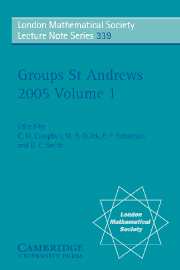Book contents
- Frontmatter
- Contents
- Introduction
- Aspects of infinite permutation groups
- Self-similarity and branching in group theory
- On surface groups: motivating examples in combinatorial group theory
- Nilpotent p-algebras and factorized p-groups
- Classification of finite groups by the number of element centralizers
- Algorithmic use of the Mal'cev correspondence
- Minimal but inefficient presentations for semi-direct products of finite cyclic monoids
- The modular isomorphism problem for finite p-groups with a cyclic subgroup of index p2
- On one-generated formations
- New results on products of finite groups
- Radical locally finite T-groups
- Explicit tilting complexes for the Broué conjecture on 3-blocks
- Conjugacy classes of p-regular elements in p-solvable groups
- An algorithm for the unit group of the Burnside ring of a finite group
- Integral group ring of the first Mathieu simple group
- Embedding properties in direct products
- Malcev presentations for subsemigroups of groups — a survey
- Finite groups with extremal conditions on sizes of conjugacy classes and on degrees of irreducible characters
- Conjugacy class structure in simple algebraic groups
- On automorphisms of products of groups
- Linear groups with infinite central dimension
- G-automata, counter languages and the Chomsky hierarchy
- An embedding theorem for groups universally equivalent to free nilpotent groups
- Irreducible word problems in groups
- Recent growth results
Integral group ring of the first Mathieu simple group
Published online by Cambridge University Press: 07 May 2010
- Frontmatter
- Contents
- Introduction
- Aspects of infinite permutation groups
- Self-similarity and branching in group theory
- On surface groups: motivating examples in combinatorial group theory
- Nilpotent p-algebras and factorized p-groups
- Classification of finite groups by the number of element centralizers
- Algorithmic use of the Mal'cev correspondence
- Minimal but inefficient presentations for semi-direct products of finite cyclic monoids
- The modular isomorphism problem for finite p-groups with a cyclic subgroup of index p2
- On one-generated formations
- New results on products of finite groups
- Radical locally finite T-groups
- Explicit tilting complexes for the Broué conjecture on 3-blocks
- Conjugacy classes of p-regular elements in p-solvable groups
- An algorithm for the unit group of the Burnside ring of a finite group
- Integral group ring of the first Mathieu simple group
- Embedding properties in direct products
- Malcev presentations for subsemigroups of groups — a survey
- Finite groups with extremal conditions on sizes of conjugacy classes and on degrees of irreducible characters
- Conjugacy class structure in simple algebraic groups
- On automorphisms of products of groups
- Linear groups with infinite central dimension
- G-automata, counter languages and the Chomsky hierarchy
- An embedding theorem for groups universally equivalent to free nilpotent groups
- Irreducible word problems in groups
- Recent growth results
Summary
Abstract
We investigate the classical Zassenhaus conjecture for the normalized unit group of the integral group ring of the simple Mathieu group M11. As a consequence, for this group we confirm the conjecture by Kimmerle about prime graphs.
Introduction and main results
Let V (ℤG) be the normalized unit group of the integral group ring ℤG of a finite group G. The following famous conjecture was formulated by H. Zassenhaus in [15]:
Conjecture 1 (ZC) Every torsion unit u ∈ V(ℤG) is conjugate within the rational group algebra ℚG to an element of G.
This conjecture is already confirmed for several classes of groups but, in general, the problem remains open, and a counterexample is not known.
Various methods have been developed to deal with this conjecture. One of the original ones was suggested by I. S. Luthar and I. B. S. Passi [12, 13], and it was improved further by M. Hertweck [9]. Using this method, the conjecture was proved for several new classes of groups, in particular for S5 and for some finite simple groups (see [4, 9, 10, 12, 13]).
The Zassenhaus conjecture appeared to be very hard, and several weakened variations of it were formulated (see, for example, [3]). One of the most interesting modifications was suggested by W. Kimmerle [11]. Let us briefly introduce it now.
- Type
- Chapter
- Information
- Groups St Andrews 2005 , pp. 237 - 245Publisher: Cambridge University PressPrint publication year: 2007
- 14
- Cited by

